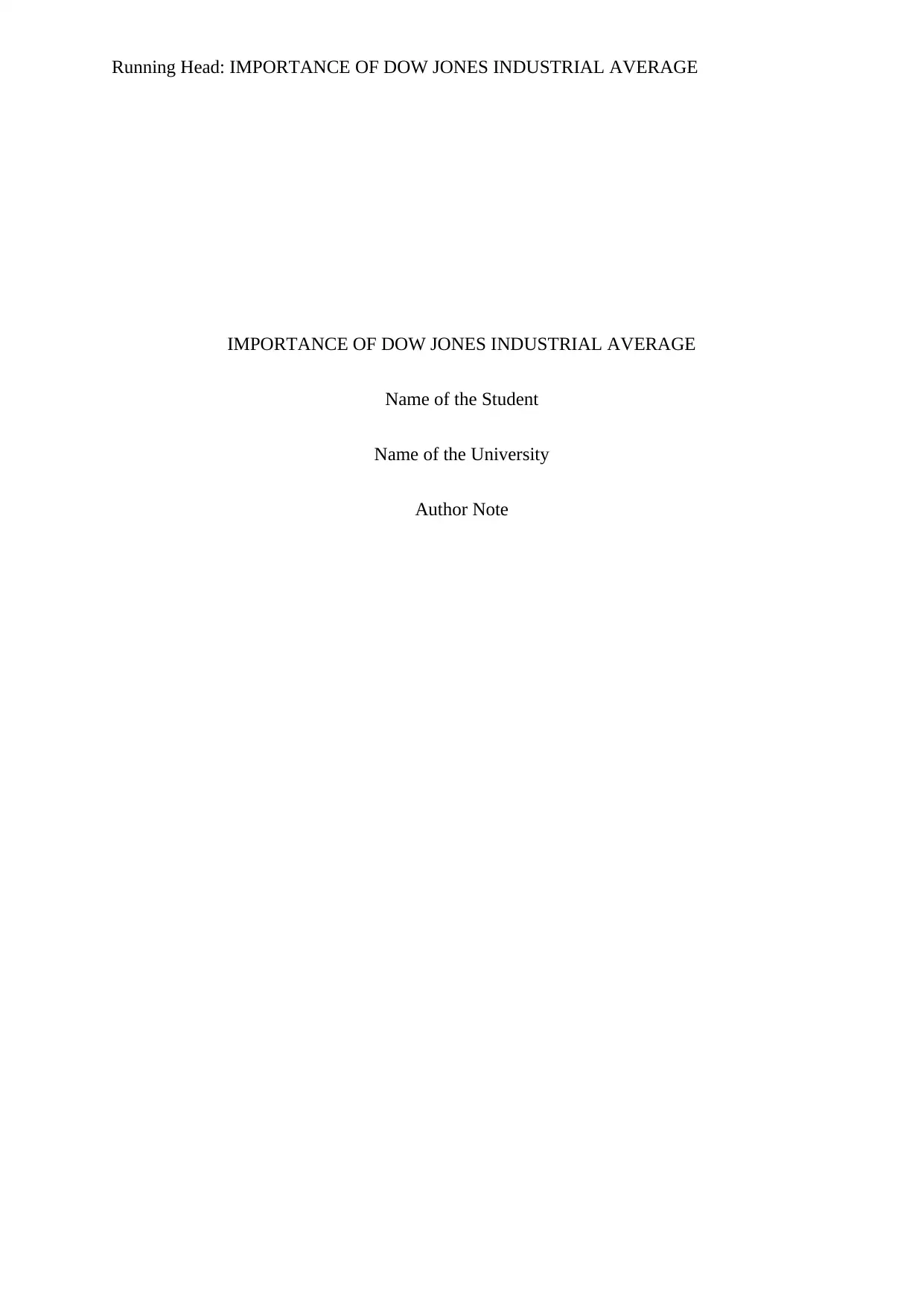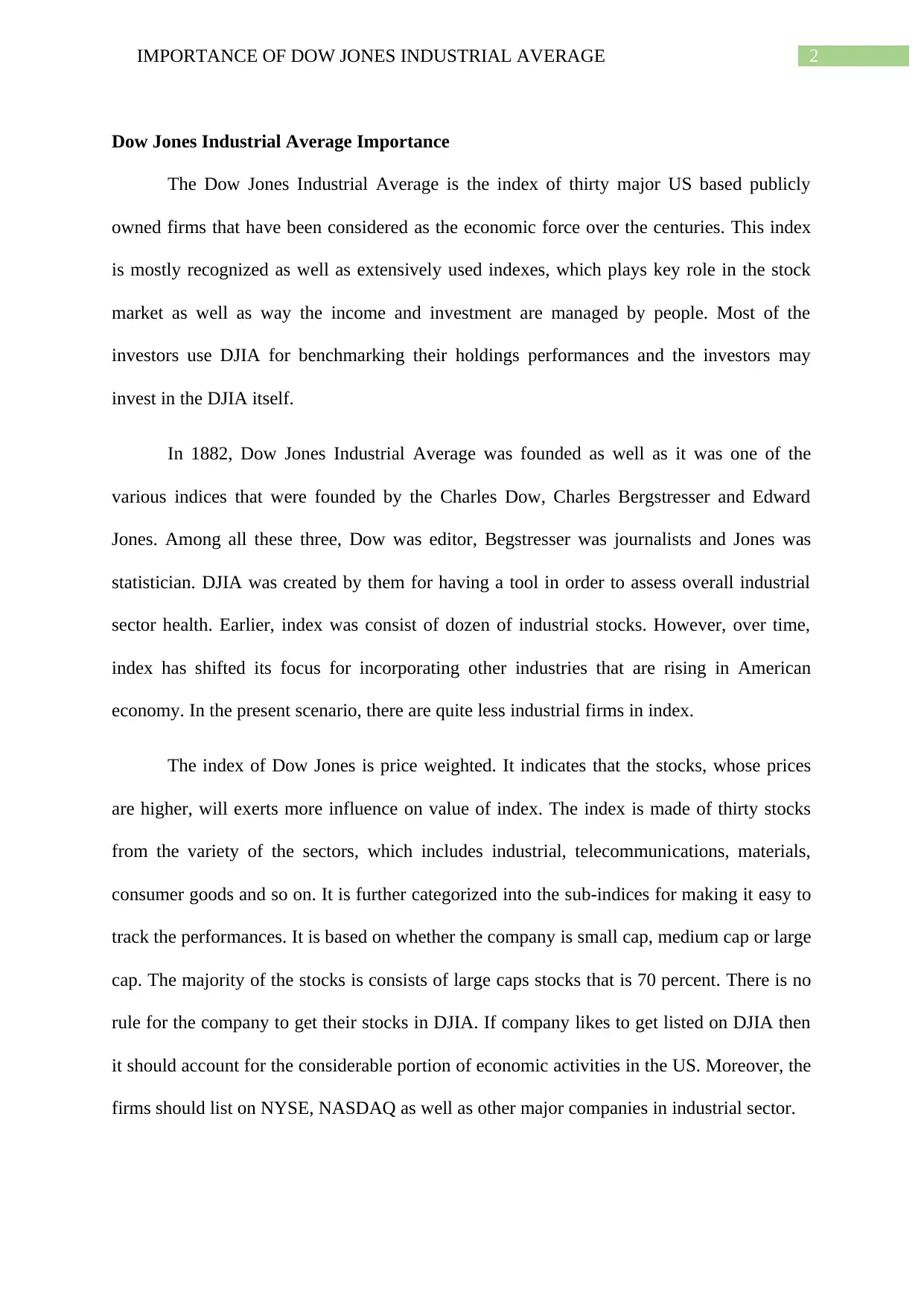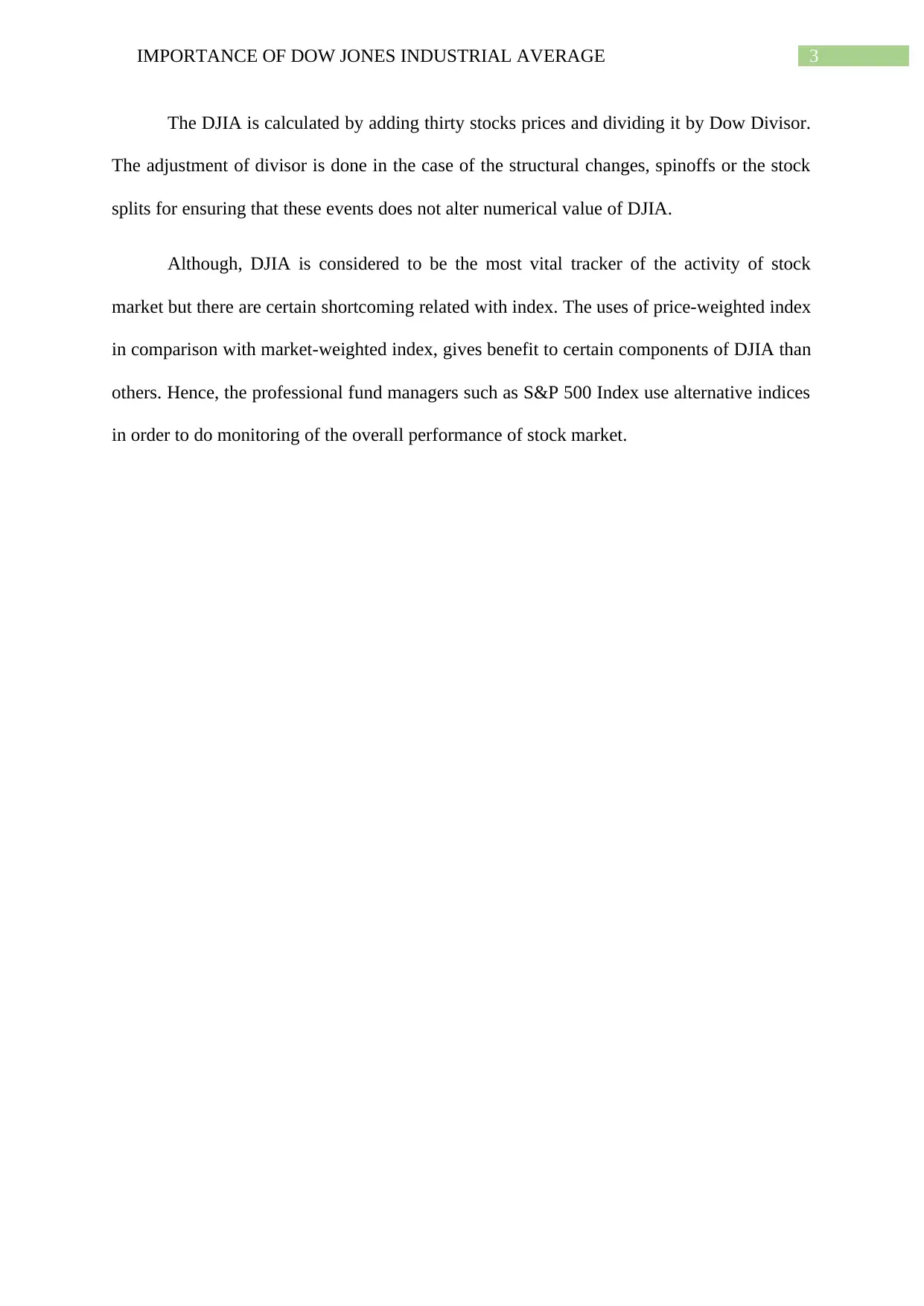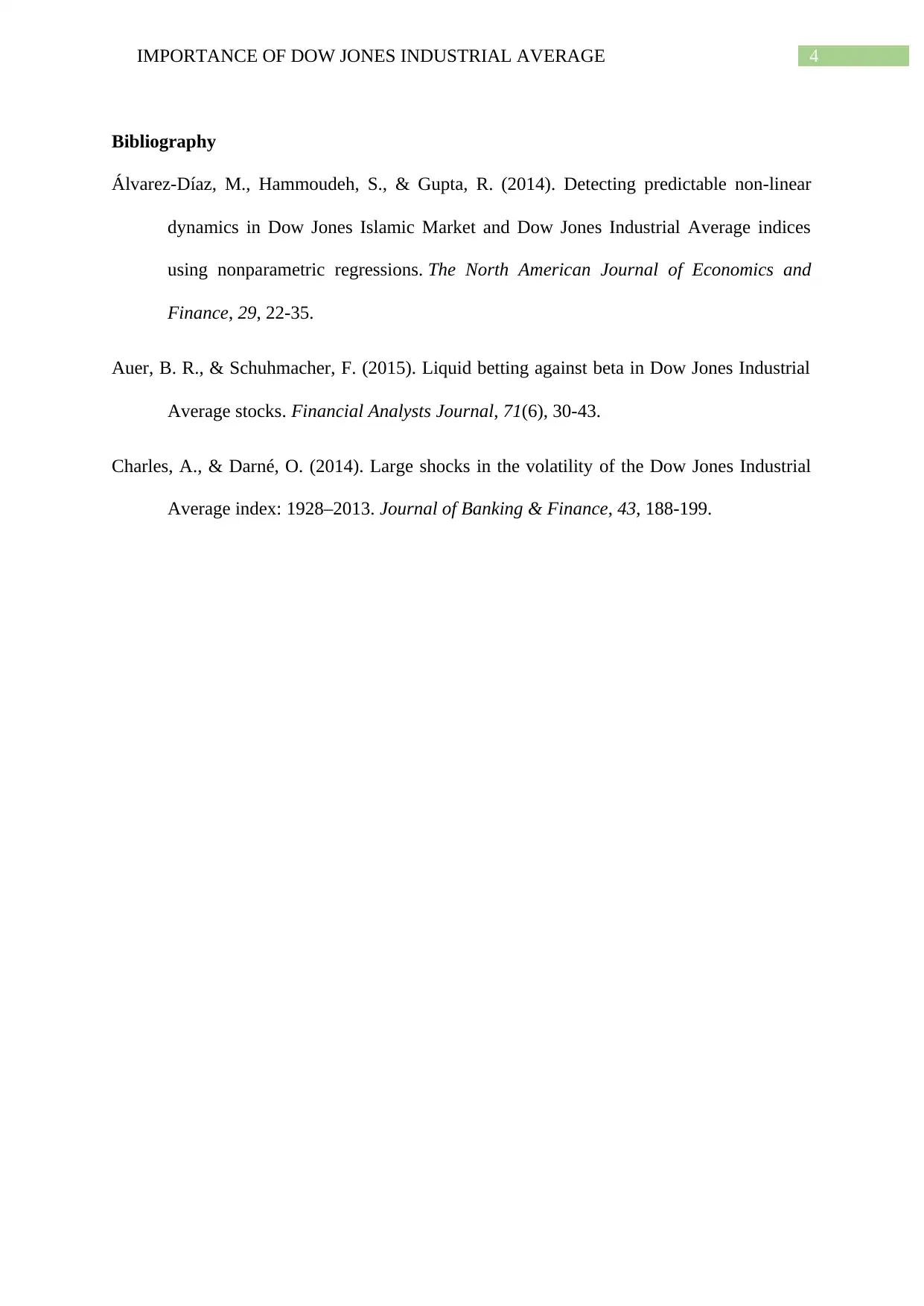A Comprehensive Report on the Dow Jones Industrial Average Importance
VerifiedAdded on 2022/09/28
|5
|653
|23
Report
AI Summary
This report examines the Dow Jones Industrial Average (DJIA), a key indicator of the U.S. stock market. The report explores the index's history, its composition of thirty major publicly owned firms, and its function as a price-weighted index. It highlights how the DJIA is used to assess market performance and provides insights into its calculation, the factors influencing its value, and its role in investment strategies. The report also acknowledges the DJIA's limitations, particularly when compared to market-weighted indices, and points to the use of alternative indices by financial professionals. The report is based on the student's research and includes relevant bibliographical references.

Running Head: IMPORTANCE OF DOW JONES INDUSTRIAL AVERAGE
IMPORTANCE OF DOW JONES INDUSTRIAL AVERAGE
Name of the Student
Name of the University
Author Note
IMPORTANCE OF DOW JONES INDUSTRIAL AVERAGE
Name of the Student
Name of the University
Author Note
Paraphrase This Document
Need a fresh take? Get an instant paraphrase of this document with our AI Paraphraser

1IMPORTANCE OF DOW JONES INDUSTRIAL AVERAGE
Table of Contents
Dow Jones Industrial Average Importance................................................................................2
Bibliography...............................................................................................................................4
Table of Contents
Dow Jones Industrial Average Importance................................................................................2
Bibliography...............................................................................................................................4

2IMPORTANCE OF DOW JONES INDUSTRIAL AVERAGE
Dow Jones Industrial Average Importance
The Dow Jones Industrial Average is the index of thirty major US based publicly
owned firms that have been considered as the economic force over the centuries. This index
is mostly recognized as well as extensively used indexes, which plays key role in the stock
market as well as way the income and investment are managed by people. Most of the
investors use DJIA for benchmarking their holdings performances and the investors may
invest in the DJIA itself.
In 1882, Dow Jones Industrial Average was founded as well as it was one of the
various indices that were founded by the Charles Dow, Charles Bergstresser and Edward
Jones. Among all these three, Dow was editor, Begstresser was journalists and Jones was
statistician. DJIA was created by them for having a tool in order to assess overall industrial
sector health. Earlier, index was consist of dozen of industrial stocks. However, over time,
index has shifted its focus for incorporating other industries that are rising in American
economy. In the present scenario, there are quite less industrial firms in index.
The index of Dow Jones is price weighted. It indicates that the stocks, whose prices
are higher, will exerts more influence on value of index. The index is made of thirty stocks
from the variety of the sectors, which includes industrial, telecommunications, materials,
consumer goods and so on. It is further categorized into the sub-indices for making it easy to
track the performances. It is based on whether the company is small cap, medium cap or large
cap. The majority of the stocks is consists of large caps stocks that is 70 percent. There is no
rule for the company to get their stocks in DJIA. If company likes to get listed on DJIA then
it should account for the considerable portion of economic activities in the US. Moreover, the
firms should list on NYSE, NASDAQ as well as other major companies in industrial sector.
Dow Jones Industrial Average Importance
The Dow Jones Industrial Average is the index of thirty major US based publicly
owned firms that have been considered as the economic force over the centuries. This index
is mostly recognized as well as extensively used indexes, which plays key role in the stock
market as well as way the income and investment are managed by people. Most of the
investors use DJIA for benchmarking their holdings performances and the investors may
invest in the DJIA itself.
In 1882, Dow Jones Industrial Average was founded as well as it was one of the
various indices that were founded by the Charles Dow, Charles Bergstresser and Edward
Jones. Among all these three, Dow was editor, Begstresser was journalists and Jones was
statistician. DJIA was created by them for having a tool in order to assess overall industrial
sector health. Earlier, index was consist of dozen of industrial stocks. However, over time,
index has shifted its focus for incorporating other industries that are rising in American
economy. In the present scenario, there are quite less industrial firms in index.
The index of Dow Jones is price weighted. It indicates that the stocks, whose prices
are higher, will exerts more influence on value of index. The index is made of thirty stocks
from the variety of the sectors, which includes industrial, telecommunications, materials,
consumer goods and so on. It is further categorized into the sub-indices for making it easy to
track the performances. It is based on whether the company is small cap, medium cap or large
cap. The majority of the stocks is consists of large caps stocks that is 70 percent. There is no
rule for the company to get their stocks in DJIA. If company likes to get listed on DJIA then
it should account for the considerable portion of economic activities in the US. Moreover, the
firms should list on NYSE, NASDAQ as well as other major companies in industrial sector.
⊘ This is a preview!⊘
Do you want full access?
Subscribe today to unlock all pages.

Trusted by 1+ million students worldwide

3IMPORTANCE OF DOW JONES INDUSTRIAL AVERAGE
The DJIA is calculated by adding thirty stocks prices and dividing it by Dow Divisor.
The adjustment of divisor is done in the case of the structural changes, spinoffs or the stock
splits for ensuring that these events does not alter numerical value of DJIA.
Although, DJIA is considered to be the most vital tracker of the activity of stock
market but there are certain shortcoming related with index. The uses of price-weighted index
in comparison with market-weighted index, gives benefit to certain components of DJIA than
others. Hence, the professional fund managers such as S&P 500 Index use alternative indices
in order to do monitoring of the overall performance of stock market.
The DJIA is calculated by adding thirty stocks prices and dividing it by Dow Divisor.
The adjustment of divisor is done in the case of the structural changes, spinoffs or the stock
splits for ensuring that these events does not alter numerical value of DJIA.
Although, DJIA is considered to be the most vital tracker of the activity of stock
market but there are certain shortcoming related with index. The uses of price-weighted index
in comparison with market-weighted index, gives benefit to certain components of DJIA than
others. Hence, the professional fund managers such as S&P 500 Index use alternative indices
in order to do monitoring of the overall performance of stock market.
Paraphrase This Document
Need a fresh take? Get an instant paraphrase of this document with our AI Paraphraser

4IMPORTANCE OF DOW JONES INDUSTRIAL AVERAGE
Bibliography
Álvarez-Díaz, M., Hammoudeh, S., & Gupta, R. (2014). Detecting predictable non-linear
dynamics in Dow Jones Islamic Market and Dow Jones Industrial Average indices
using nonparametric regressions. The North American Journal of Economics and
Finance, 29, 22-35.
Auer, B. R., & Schuhmacher, F. (2015). Liquid betting against beta in Dow Jones Industrial
Average stocks. Financial Analysts Journal, 71(6), 30-43.
Charles, A., & Darné, O. (2014). Large shocks in the volatility of the Dow Jones Industrial
Average index: 1928–2013. Journal of Banking & Finance, 43, 188-199.
Bibliography
Álvarez-Díaz, M., Hammoudeh, S., & Gupta, R. (2014). Detecting predictable non-linear
dynamics in Dow Jones Islamic Market and Dow Jones Industrial Average indices
using nonparametric regressions. The North American Journal of Economics and
Finance, 29, 22-35.
Auer, B. R., & Schuhmacher, F. (2015). Liquid betting against beta in Dow Jones Industrial
Average stocks. Financial Analysts Journal, 71(6), 30-43.
Charles, A., & Darné, O. (2014). Large shocks in the volatility of the Dow Jones Industrial
Average index: 1928–2013. Journal of Banking & Finance, 43, 188-199.
1 out of 5
Related Documents
Your All-in-One AI-Powered Toolkit for Academic Success.
+13062052269
info@desklib.com
Available 24*7 on WhatsApp / Email
![[object Object]](/_next/static/media/star-bottom.7253800d.svg)
Unlock your academic potential
Copyright © 2020–2025 A2Z Services. All Rights Reserved. Developed and managed by ZUCOL.





